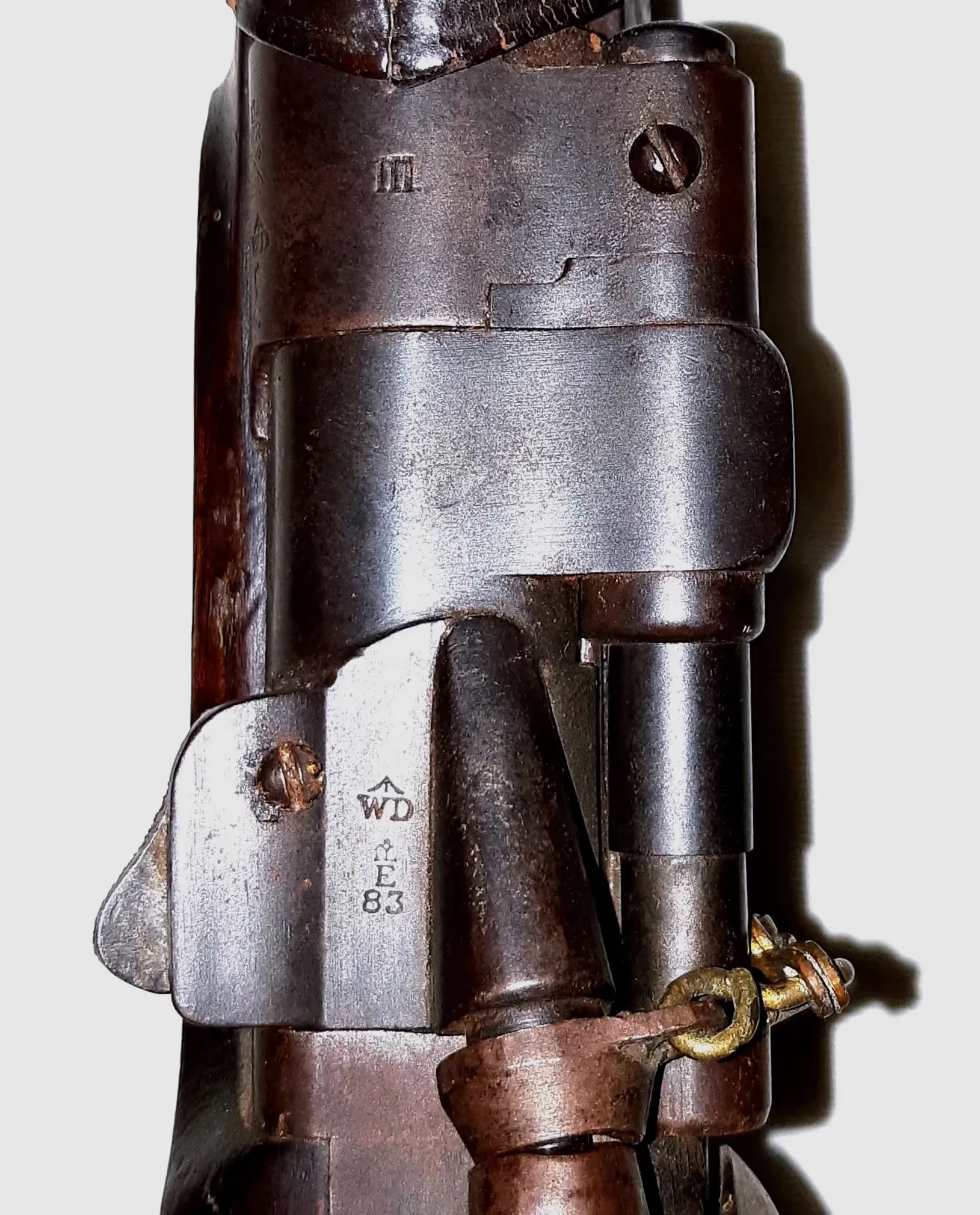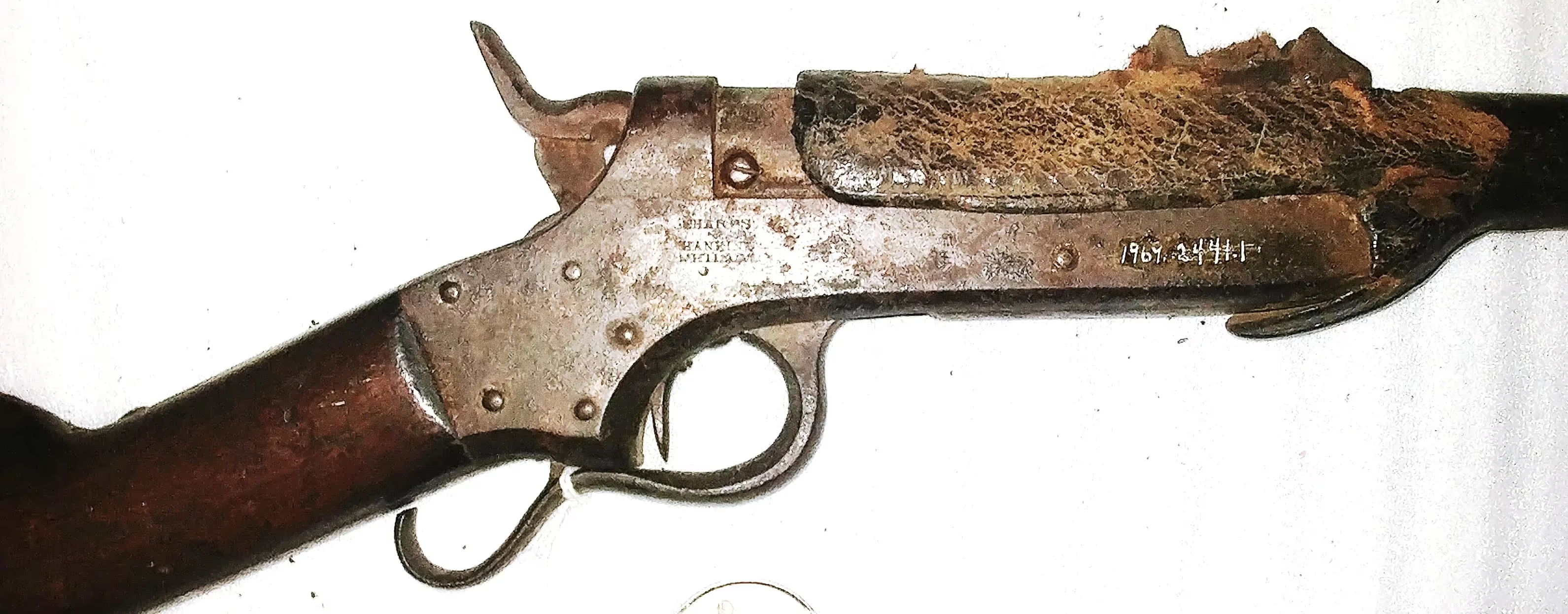Rifles and Shotguns, York Sunbury Historical Society, Fredericton Region Museum artefacts
Rifles and Shotguns in the Fredericton Region Museum Collection
The York Sunbury Historical Society (YSHS) administers the Fredericton Region Museum (FRM), formerly known as the York Sunbury Museum. The FRM is a small, non-profit museum founded in 1934 by the YSFS. The FRM was housed in several different locations until 1959, when it moved into the former military barracks located on the West side of Officers' Square on Queen Street in Fredericton, New Brunswick. The FRM focuses on preserving the history of the York and Sunbury region as well as central New Brunswick. The FRM possesses a large and diverse collection of artefacts, including an extraordinary firearms collection, a few of which are illustrated here. The firearms have all been deactivated. The photos of these firearms are by the FRM staff and by the author as credited.
Musée de la région de Fredericton, Carabines et fusils de chasse
Le Fredericton Region Museum, anciennement connu sous le nom de York Sunbury Museum, est un petit musée sans but lucratif fondé en 1934 par la York Sunbury Historical Society. Le musée a été installé dans plusieurs endroits différents jusqu'en 1959, date à laquelle il a emménagé sur la place des Officiers sur la rue Queen à Fredericton, au Nouveau-Brunswick. Le Fredericton Region Museum se concentre sur la préservation de l'histoire de la région de York et de Sunbury ainsi que du centre du Nouveau-Brunswick. Le musée possède une grande et diversifiée collection d'objets, dont une extraordinaire collection d'armes à feu, dont quelques-unes sont illustrées ici. Les armes à feu ont toutes été désactivées. Les photos des armes légères trouvées dans le musée sont de l'auteur ou créditées.
.avif)


1969.198.1 Ramsey Sutherland percussion carbine .67 cal. (FRM Photos)
.avif)


1969.456.1 Sudanese smoothbore muzzle-loading rifle 0.303 cal. (FRM Photos)


1969.2130.1 Ross Mk. II rifle 0.303 cal. (FRM Photos)
.avif)
.avif)
.avif)
1969.2431.1 Enfield 1862 carbine .577 cal. (FRM Photos)
.avif)
.avif)
.avif)


1969.2432.1, E.M. Reilly & Co., London, 10 ga. DB pinfire shotgun, (Serial No. 15259). (FRM Photos)



1969.2433.1 Richardson & Overman 12 ga. shotgun (Serial No. 21821). (FRM Photos)




1969.2434.1 I Hollis and Sons shotgun 12 ga. (FRM Photos)







1969.2435.1 Snider-Enfield 1871 carbine (Serial No. 1937) 0.577 cal. (FRM Photos)
Henry Stevens noted that he had tracked down 24 of these carbines, including this one in the FRM. Most of them have a connection to Canada, either owned by or sold by people in this country, and a couple found outside of Canada were purchased here in Canada and then exported. All of them have an I/Broad arrow mark in either up-arrow-over-I, or I-over-down-arrow configuration on the lock. Most of them have I-over-down-arrow in the roundel, like this one. The I-broad arrow is usually associated with arms tasked for India, hence the mystery. 12 of the 24 have a D.C. (Dominion of Canada) marking. A few do not have the D.C. marking. Most, like the FRM's, have the D.C. without a roundel, stamped on the left hand side of the buttstock. Several have regimental markings stamped into the buttplate tang. They are a random assortment of markings, with no common association so far. The number “23” on this carbine is either a rack or an inventory number, as many of these carbines have numbers stamped obliquely on the stock in that location, though most are on the right hand side near the roundel. The numbers go up to 118. What may be a regimental number is the “4” over what looks like “181”. That could mean carbine number “181” held by the 4th Hussars (4th Regiment of Cavalry).
.avif)
.avif)
1969.2436 AD & Co., New London whaling gun 1-3/4-in. (FRM Photos)

.avif)
.avif)
1969.2437.1 Winchester M1873 rifle (Serial No. 173300A) .44 cal. (FRM Photos)
%2520(2).avif)
.avif)
.avif)
1969.2438.1 Mauser M1884 rifle (Serial No. 1175) 6.5X55 cal. The SerialNo. is on boththe barrel and wooden stock. (Author Photos)
.avif)
.avif)
.avif)
1969.2439.1 Spencer M1860 rifle (Serial No. 6) 0.52 RF. (FRM Photos)
.avif)
.avif)
.avif)
1969.2440.1 Sharps M1863 carbine (Serial No. 76935) 0.52 cal. (FRM Photos)




1969.2441.1 Sharps & Hankins naval carbine (Serial No. 9863) .52 RF. (FRM Photos)


1969.2442.1 Star M1898 carbine .054 cal., with saddle ring. (FRM Photos)
This is a single shot breech-loading rifle designed in the USA in 1858, primarily for use by horse-mounted cavalry. It weighs 7.4 lbs. The Star carbine fired paper or linen cartridges that were ignited by conventional percussion caps. The weapon fired reliably as long as the lengthy flash channel was kept clean.
.avif)
.avif)
.avif)
1969.2443.1 Evans carbine .44 CF repeating action carbine (transition model). (FRM Photos)
The Evans was invented by Warren R. Evans, a dentist from Thomaston, Maine. With the help of his brother George, they perfected the rifle and started the "Evans Rifle Manufacturing Company" of Mechanic Falls, Maine in 1873. Their rifles were marketed by Merwin & Hulbert. The hope was that the rifle would be issued by the United States Army, but the rifle failed the standard dust test. The rifle has a radial block receiver similar to the Spencer, but the rounds were fed from an Archimedean-screw magazine which formed the spine of the rifle stock and could hold up to 28 rounds. The fluted cartridge carrier made a quarter turn each time the lever was operated, feeding a new cartridge into the breech. The Evans repeating rifle holds the distinction of being the only firearm mass-produced in the state of Maine in the 19th century. The Evans rifle also had the greatest magazine capacity of any rifle mass-produced in the 19th Century. The Evans has a rotary helical magazine in the buttstock, and cartridges are fed into the breech by cycling the cocking lever/trigger guard. Also, the magazine of the Evans has a much higher capacity than that of the Spencer, up to 28 rounds. The Evans holds four rows of cartridges which are loaded through a trapdoor in the buttplate. Each time the action is cycled, the magazine feeds the next cartridge to the breech in a helical pattern. By early 1876, Evans modified the original and began producing the so-called Transition model. Unlike the old model, the transition model had a walnut lower buttstock, as well as a redesigned buttplate. These changes improved the balance of the rifle, as well as protecting it from damage. Barrel markings on the transition model are as follows: “Evans Repeating Rifle Mechanic Falls Me./Pat, Dec. 8, 1868 & Sept. 16, 1871”. Only 450 carbine versions were made.
.avif)
.avif)
.avif)
1969.2444.1 P. Webley & Son rifle (Serial No. 8297), D445, 0.455 cal. (FRM Photos)
.avif)
.avif)
.avif)
(FRM Photos)
1969.2445.1 Enfield M1896 LEC I carbine (Serial No. 516) 0.303 cal.
.avif)
.avif)
.avif)
1969.2446.1 Enfield M1863 carbine (Serial No. 47C) 0.577 cal. (FRM Photos)
.avif)
.avif)
.avif)
1969.2520.1 Sharps & Hankins M1862 rifle (Serial No. 11855) .52 RF. (FRM Photos)
.avif)
.avif)
.avif)
.avif)
1969.2523.1 British India pattern smoothbore muzzle-loading musket. (FRM Photos)


1969.2524.1 British India pattern smoothbore muzzle-loading rifle 0.38 cal. Missing the firing furniture. (Author Photos)
.avif)
.avif)
.avif)
1969.2535.1 British proofs shotgun 15 ga. (FRM Photos)
.avif)
.avif)
.avif)
.avif)
1969.3038.1 Ketland & Co. Short Land musket 0.75 cal. (FRM Photos)
.avif)
.avif)
.avif)
1969.3039.1 Ketland & Co., Long Fowler percussion. (FRM Photos)
.avif)
.avif)
.avif)
.avif)
1969.3041.1 Ketland London Long Fowler over-and-under shotgun 18 ga. (FRM Photos)
.avif)
.avif)
.avif)
1969.3042.1 USA ca 1835 rifle 3X.41 cal. (FRM Photos)
.avif)
.avif)
.avif)
1969.3043.1 Enfield M1861 rifle 0.577 cal. (FRM Photos)
.avif)
.avif)
.avif)
1969.3059.1. Enfield 1844 .577 cal SS percussion carbine sling swivel rod. (FRM Photos)
.avif)
.avif)
.avif)
1969.3060.1, Enfield .79 cal P 1838 Sgt SS Rifle. (FRM Photos)
.avif)
.avif)
.avif)
1969.3115.1 Ramsey Sutherland Baker rifle 0.65 cal. (FRM Photos)
.avif)
.avif)
.avif)
1969.3117.1 33. Enfield M1867, Snider-Enfield .577 cal SS rifle. (FRM Photos)
.avif)
.avif)
.avif)
1969.3238.1 Tower Short Land 0.75 cal. musket. (FRM Photos)
.avif)
.avif)
.avif)
1969.3239.1 Enfield M1867 Snider-Enfield rifle 0.577 cal. (FRM Photos)
.avif)
.avif)
.avif)
1969.3240.1, Springfield Model 1888 45-70 cal SS percussion rifle, 1884. (FRM Photos)
.avif)
.avif)
.avif)
1969.3241.1 Springfield M1888 rifle (Serial No. 525326) 45-70 cal. (FRM Photos)

1969.3242.1 Snider-Enfield M1872 rifle 0.577 cal. (Author Photo)
.avif)
.avif)
.avif)
1978.2.1 Perkins smoothbore muzzle-loading musket. (FRM Photos)
%2520(17).avif)
%2520(18).avif)
%2520(16).avif)
1985.5.1 Tower smoothbore muzzle-loading musket 0.75 cal. (FRM Photos)
.avif)
.avif)
.avif)
1992.32.1 Adam & Co., shotgun (Serial No. 10384) 12 ga. (FRM Photos)
.avif)
.avif)
.avif)
(FRM Photos)
2015.5.1. Ramsey Sutherland British India pattern smoothbore muzzleloading .75 cal musket with a 39-inch barrel. This firearm was built for the British ordinance by a contractor named Sutherland, c1779-1793. An Enfield Snyder conversion may have been attempted, resulting in a portion of the breech being cut away. Donated by Arthur Nason in 2013.
%252C%2520FRM%252C%25205%2520Nov%25202022%2520(4).avif)
2013. Lee-Enfield Mk. III* rifle (Serial No. R4670), 513 crossed out, 0.303 cal. (FRM Photos)
.avif)


2013. SMLE Mk. III* rifle (Serial No. R76951) 0.303 cal. Shown here with bayonet fixed. (Author Photos)

(Author Photos)
SMLE Mk. III rifle and Ross rifle comparison - note that although the barrel is longer on the Ross rifle and the bayonet shorter than the SMLE, the reach is nearly identical.

(Library and Archives Canada Photo, MIKAN No. 3520967)
Sentry with Ross rifle and fixed bayonet, 22nd Infantry Battalion (Canadien-Français), July 1916.
.avif)



2013. Ross rifle 0.303 cal. Shown here with bayonet fixed. (Author Photos)
.avif)
.avif)
.avif)
1980.8.1 Mauser M1871 rifle (Serial No. 4125) 11-mm. (FRM Photos)

.avif)
.avif)
.avif)
2015.9.1 Springfield M1880 musket. (FRM Photos)
.avif)
.avif)
.avif)
2024.6.1 Zulu percussion carbine. (FRM Photos)

